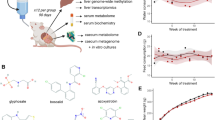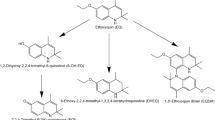Abstract
Background 2-Amino-3-methyl-imidazo[4,5-f]quinoine (IQ) is a mutagen produced in cooked food. It is commonly present in the human diet and often used as a (pro)carcinogen for chemoprevention studies. Many foodstuffs act as chemopreventers by altering xenobiotic metabolising enzyme expression in favour of detoxication over bioactivation pathways. However, IQ itself can also affect enzyme expression, which may be a confounding factor in chemoprevention studies. Aim of the study Chronic low dose IQ exposure is intuitively closest to the human dietary situation. The aim was to investigate the effects of chronic dietary exposure to IQ on the expression of enzymes involved in the bioactivation and detoxification of xenobiotics and to compare this with acute exposure, often used in chemoprevention studies. Methods Male Fischer rats received IQ (300 ppm) in the diet (AIN-76) for 52 weeks or were given IQ (20 mg · kg−1) orally for 3 days. Animals were killed, livers removed and subcellular fractions prepared. A range of enzymes was selected to allow investigation of several cellular mechanisms. Enzyme expression and activity were determined by Western blotting and the use of selective probe substrates as appropriate. Results Chronic exposure to IQ led to an increase in phase II detoxifying enzymes. Both the activity and expression of glutathione S-transferase (GST-A1/2) were increased, as were NADPH: Quinone oxidoreductase (NQO), UPD-glucuronosyl transferase (UGT) and β-glucuronidase activities. There were no statistically significant changes in the potential for bioactivation by three cytochrome P450s. In contrast, acute IQ exposure significantly increased the expression and activity of some cytochrome P450 (CYP1A1 and CYP1A2), UGT and β-glucuronidase, but significantly decreased glutathione S-transferase expression and activity. There was a non-significant decrease in NQO but no change in CYP3A2 and CYP2E1 activities. Conclusions The changes after acute exposure suggest an interaction through the Ah receptor and xenobiotic response element, modified by the glucocorticoid response element. In contrast, the pattern of effects activation of the antioxidant response element (ARE). Although the acute model is more practically convenient for short-term chemoprevention screening, the data suggest that an entirely new mechanism is being invoked that completely masks effects of the ARE that occur during chronic exposure. There is a danger that chemopreventive strategies developed using acute models may be misleading, since the mechanism is unlikely to occur during human dietary exposures.
Similar content being viewed by others
Author information
Authors and Affiliations
Additional information
Received: 20 September 2000, Accepted: 17 January 2001
Rights and permissions
About this article
Cite this article
McPherson, R., Tingle, M. & Ferguson, L. Contrasting effects of acute and chronic dietary exposure to 2-amino-3-methyl-imidazo[4,5-f]quinoline (IQ) on xenobiotic metabolising enzymes in the male Fischer 344 Rat: implications for chemoprevention studies. Eur J Nutr 40, 39–47 (2001). https://doi.org/10.1007/PL00007384
Issue Date:
DOI: https://doi.org/10.1007/PL00007384




